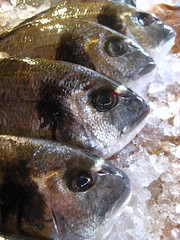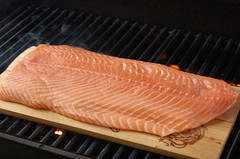 If you want to serve your family the most delicious fresh fish, here are some quick tips from the nonprofit Consumers Union (and from me) to ensure you're buying the freshest fish:
If you want to serve your family the most delicious fresh fish, here are some quick tips from the nonprofit Consumers Union (and from me) to ensure you're buying the freshest fish:*Sniff the fish before you buy. If it has a strong fishy smell, don't buy it. Fresh fish smells clean and like the ocean, not like cat food.
*Fish should be on ice or in a refrigerated case. If it's not, don't buy it.
*Steaks and fillets should have firm flesh. If the flesh looks slimy or dried out, or if it has gaps between the muscle fibers or if it has spots, don't buy it.
*Whole fish should have clear eyes and bright red gills. If the eyes are cloudy, don't buy it.
*Buy fish or seafood last so that it stays as cold as possible. If you get it early and then cart it around the store as you finish your shopping, bacteria can start to grow as the fish's temperature gets warmer.
*If your drive home is more than a few minutes (especially on hot days), ask the seafood counter clerk to pack your fish with a bag of ice to keep it cool. Better yet, have a cooler with ice in your car for the drive home.
 *Get to know your fishmonger. Ask him or her what day of the week fish is delivered to the store, and ask what's freshest. If the source/origin of the fish isn't posted, ask where it's coming from.
*Get to know your fishmonger. Ask him or her what day of the week fish is delivered to the store, and ask what's freshest. If the source/origin of the fish isn't posted, ask where it's coming from.*If possible, buy local fish and seafood. The shorter the travel from the body of water to the store, the fresher it probably is.
*Refrigerate fresh fish as soon as you get home, and use the same day or in any event within 2 days. If you don't plan on eating it that soon, wrap it well (airtight) and freeze.
Zestfully yours,
Gloria
PS: If you love eating fish, check out our partner The Crab Place for some of the freshest fish the East Coast has to offer. All of their fresh fish is wild-caught from U.S. waters. Be sure to check out our Fresh Fish Specials for money-saving deals on salmon, rockfish, flounder, red snapper, swordfish and tuna.

























No comments:
Post a Comment